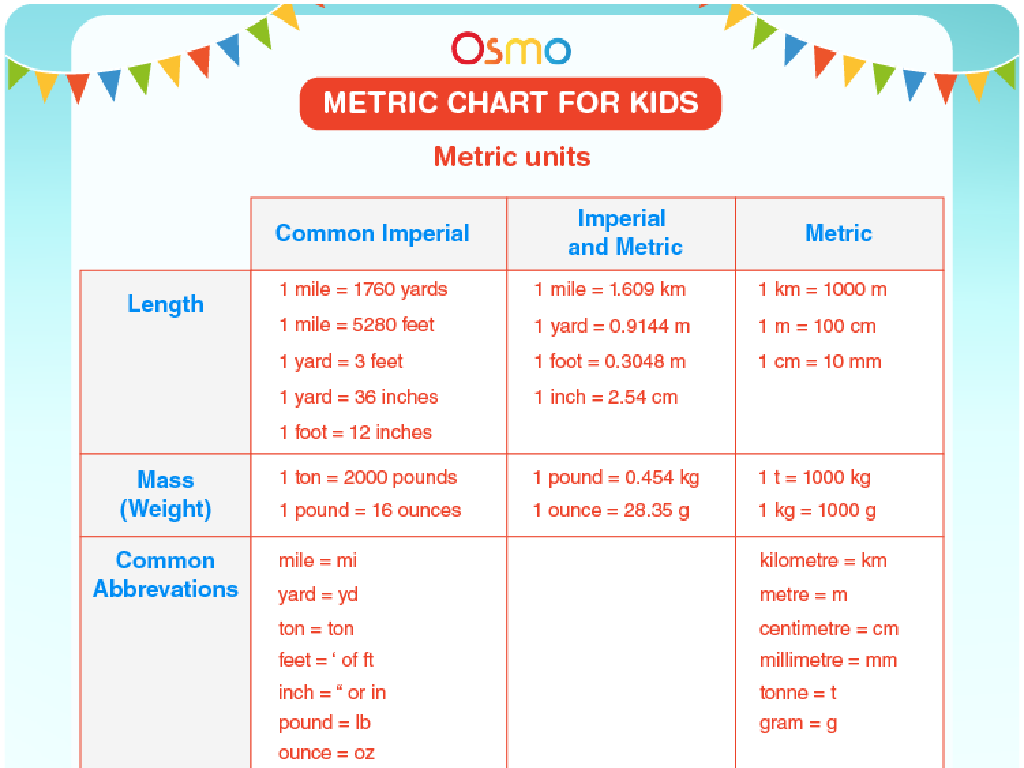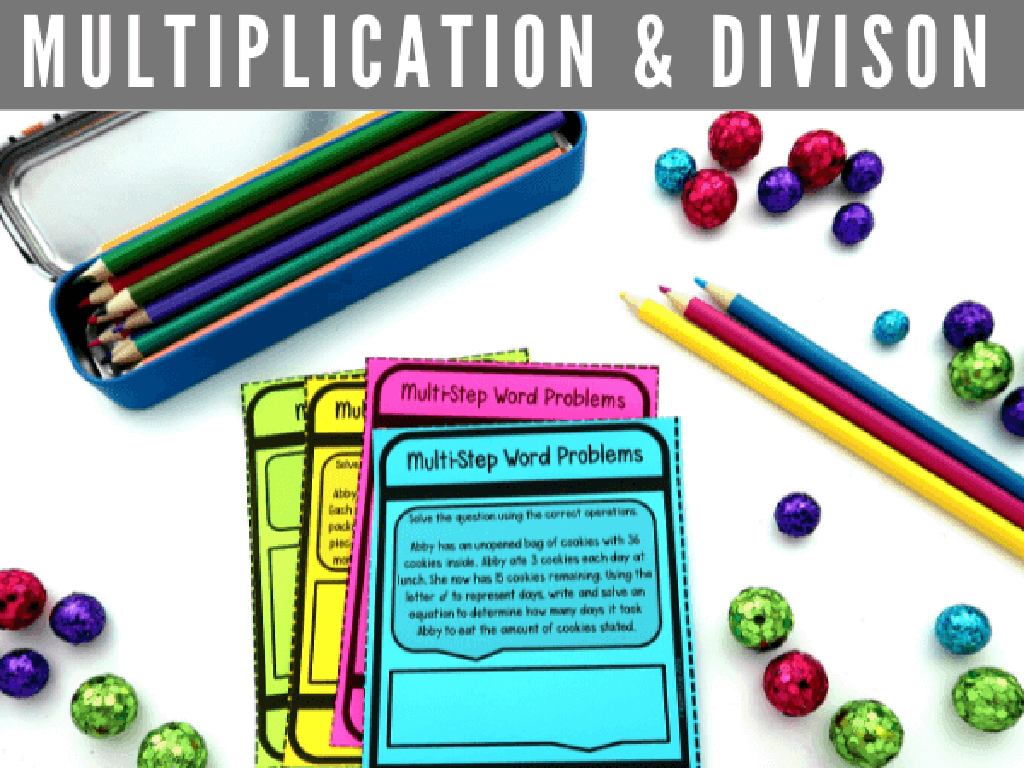Read Realistic Fiction
Subject: Language arts
Grade: Second grade
Topic: Read-Alone Literary Texts
Please LOG IN to download the presentation. Access is available to registered users only.
View More Content
Welcome to Realistic Fiction!
– Exploring realistic fiction stories
– Realistic fiction defined
– Stories that seem real but are made up
– Why we enjoy these stories
– They reflect real-life experiences and emotions
– Connecting fiction to real life
– Helps relate to characters and situations we may know
|
Today’s lesson introduces students to the genre of realistic fiction, which includes stories that could actually happen in real life. These stories are made-up but believable, and they often involve characters and situations that students can relate to or recognize from their own experiences. Discussing why we enjoy realistic fiction can open a conversation about empathy and understanding different perspectives. Encourage students to think about how these stories can provide both entertainment and lessons about life. Ask them to consider how the characters’ experiences might be similar or different from their own.
Elements of Realistic Fiction
– Characters that feel real
– Think of friends or pets with unique personalities
– Setting: Places we can find
– Like your school or a city park
– Plot: Real-life events
– Like solving a mystery at school
– Understanding through examples
|
This slide introduces students to the key elements that make up realistic fiction. Characters in these stories are similar to real people or animals, with behaviors and emotions that students can relate to. The setting is where the story takes place and should be familiar or plausible to the students, such as their own school or a local park. The plot consists of events that could happen in real life, like finding a lost item or making a new friend. Use examples from well-known children’s books to illustrate these points. Encourage students to think of their own experiences that could make a good realistic fiction story, fostering a deeper connection with the material.
Characters We Can Relate To
– Realistic characters have real feelings
– They may feel happy, sad, or scared
– Characters from diverse backgrounds
– They could be from anywhere in the world
– They face problems just like us
– Their struggles are similar to our own
– Imagine being friends with a character
– Think of a character you’d like to meet
|
This slide aims to help students connect with characters in realistic fiction by recognizing the emotions and experiences that mirror their own lives. Discuss how characters in these stories have complex feelings and face challenges, just like the students do. Emphasize the diversity of characters they may encounter, coming from various backgrounds and cultures. Encourage students to think about which characters they relate to and why they would want to be friends with them. This exercise not only enhances empathy but also deepens their engagement with the reading material. In the next class, ask students to share about a character they found relatable and discuss what makes that character’s experiences realistic.
Exploring Settings in Realistic Fiction
– Recognize familiar settings
– Settings like school, home, or a park
– Imagine a story’s setting
– Think of a place you know for a story
– Draw your story’s setting
– Share your setting with the class
– Present your drawing and describe it
|
This slide is designed to help second-grade students understand the concept of setting in realistic fiction. Begin by discussing settings that are familiar to the students, such as their school, homes, or local parks. Encourage them to think of other places they know where a story could take place. This will help them connect personally with the stories they read. The drawing activity allows students to visualize and create a setting for their own story, fostering creativity and engagement. When sharing their drawings, students practice speaking skills and learn to appreciate different settings imagined by their peers. Provide guidance on what elements make a setting realistic and relatable.
Plots That Feel Real in Realistic Fiction
– Realistic fiction has a structure
– It starts with a beginning, has a middle, and ends satisfyingly.
– Events link together logically
– Like real life, one event leads to the next in a sensible way.
– Let’s craft a simple plot
– We’ll use our imaginations to make a story that could really happen.
|
This slide introduces students to the structure of realistic fiction, emphasizing that it mirrors real life with a clear beginning, middle, and end. The events within the story are interconnected and follow a logical sequence, just as they do in the real world. Engage the class in a collaborative activity where they create a simple plot for a realistic fiction story. This could involve brainstorming a setting, characters, and a problem they need to solve, then guiding them through the process of developing a resolution. This activity will help students understand plot development and the importance of coherence in storytelling.
Making Connections with Realistic Fiction
– Relating to the story’s events
– Comparing our experiences to characters’
Think of a time you felt like the character. Were you happy, scared, or excited?
– Sharing personal stories
Tell us about a similar adventure or problem you’ve faced.
– Understanding characters’ feelings
How would you feel in the character’s place?
|
This slide aims to help students make personal connections with the realistic fiction they read, which can enhance their understanding and empathy. Encourage them to think about times they’ve felt similar emotions or faced similar situations as the characters in the story. Facilitate a discussion where students can share their own experiences that remind them of the book’s events. This activity not only deepens their comprehension but also fosters a sense of community and shared experiences in the classroom. It’s important to create a supportive environment where students feel comfortable sharing their personal stories.
Reading Time: Exploring Realistic Fiction
– Read a realistic fiction story
– Focus on characters, setting, plot
– Who are the people? Where and when is it happening?
– Think about what feels real
– Which parts of the story could happen in real life?
– Get ready to discuss the story
|
This slide is designed to engage second-grade students in a group reading activity focused on realistic fiction. Realistic fiction stories are narratives that could happen in real life, with relatable characters and settings. As the story is read aloud, encourage students to pay close attention to the details of the characters, setting, and plot. After reading, facilitate a discussion where students can express what parts of the story felt real to them and why. This activity helps students make personal connections with the text and enhances their comprehension skills. It’s also an opportunity to introduce the concept of plot and character development within a story that is accessible and engaging for their age group.
Class Activity: Create Your Own Story
– Become an author today!
– Invent your own character
– Think of someone you’d like to read about
– Pick where your story happens
– Is it in a park, at home, or outer space?
– Plan out a fun plot
– What exciting things will happen?
|
This activity is designed to spark the students’ creativity by allowing them to step into the role of an author. Provide guidance on character creation by suggesting they think of qualities they admire in people or animals. For setting, encourage them to think of places they find interesting or fun. When discussing the plot, prompt them to think of a problem the character could solve or an adventure they could go on. Provide paper for drawing and writing, and let them know that their stories will be shared with the class. This will help them understand the elements of realistic fiction by creating it themselves. Possible activities could include creating a story about a new student, a lost pet, a family trip, or a school event.
Share Your Stories: Presenting Realistic Fiction
– Present your story to the class
– Discuss your favorite part of creating it
– Was it designing characters or the plot?
– Explain how you made your story realistic
– Did you use real-life experiences or detailed descriptions?
– Reflect on the storytelling process
|
This slide is for a class activity where students will share the realistic fiction stories they have created. Encourage each student to speak about their story, what they enjoyed most during the creative process, and how they managed to make their story feel real and relatable. This could involve using their own experiences, creating vivid characters, or describing settings in detail. Teachers should guide students to reflect on their creative process and think critically about what makes a story engaging. Provide a supportive environment for students to present and positive feedback to build their confidence in storytelling.
Celebrating Our Reading Journey
– Applause for your hard work today
– Understanding realistic fiction
– Stories that could happen in real life
– Continue reading at home
– Pick your favorite books to read
– Create your own stories
– Use your imagination to write
|
This slide is meant to wrap up the lesson on realistic fiction. Praise the students for their effort and participation. Reinforce the key lesson that realistic fiction includes stories that mimic real life, which they can relate to and learn from. Encourage them to keep reading at home, choosing books that interest them, and to use their creativity to come up with their own realistic stories. This not only fosters a love for reading but also helps develop their writing skills. Remind them to think about the characters, settings, and events that make a story believable. Celebrate their progress in understanding literature.






